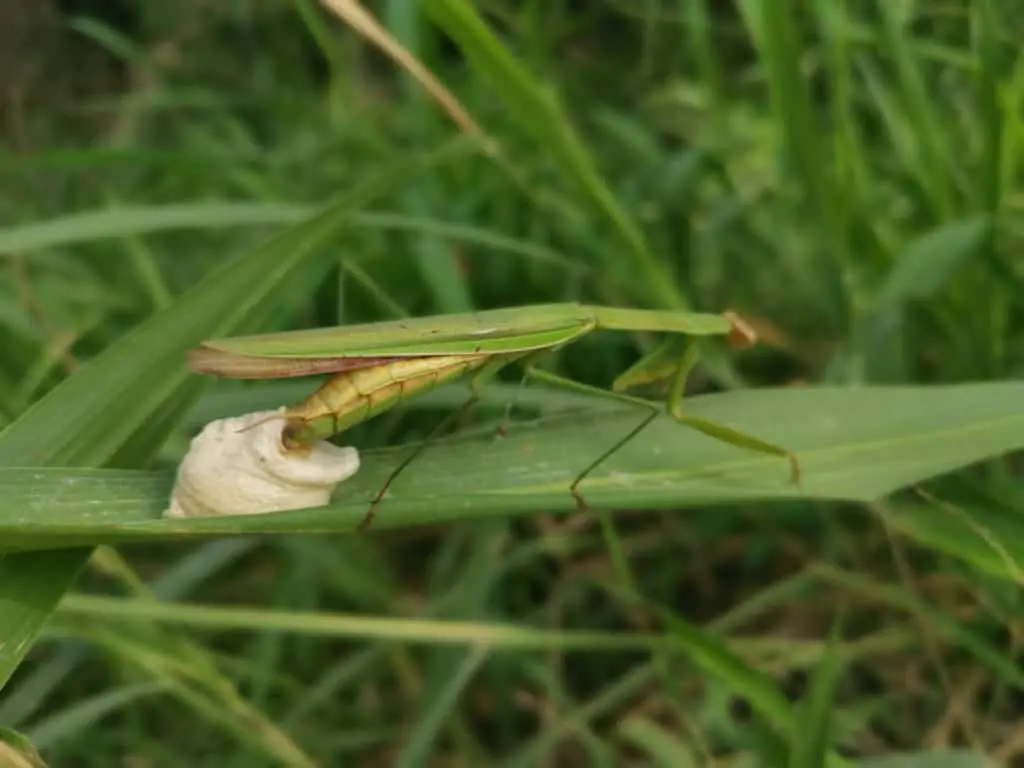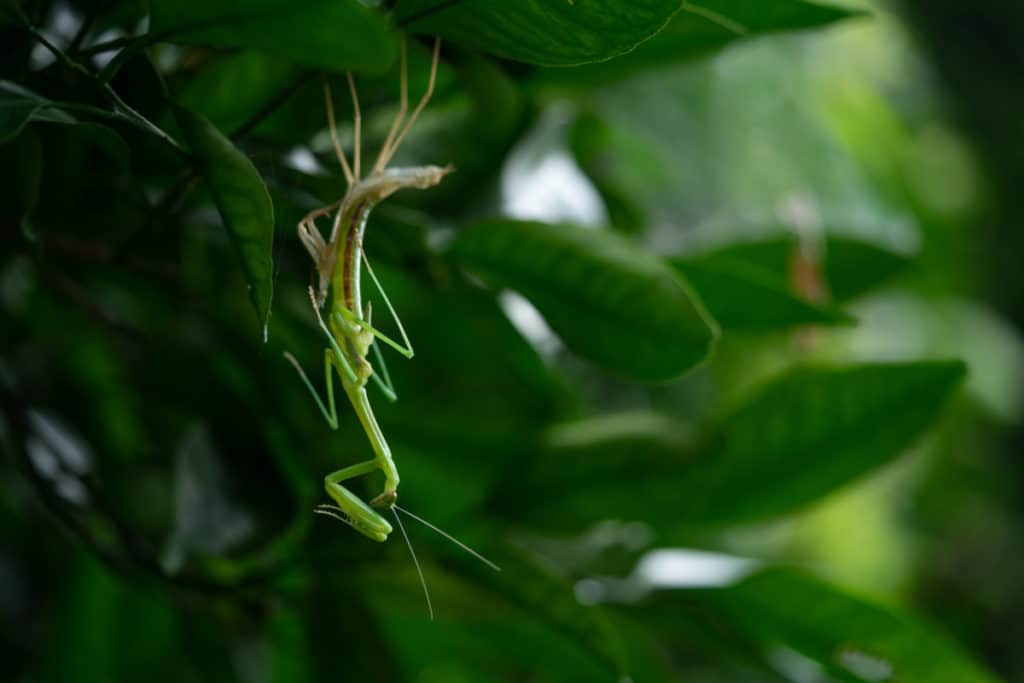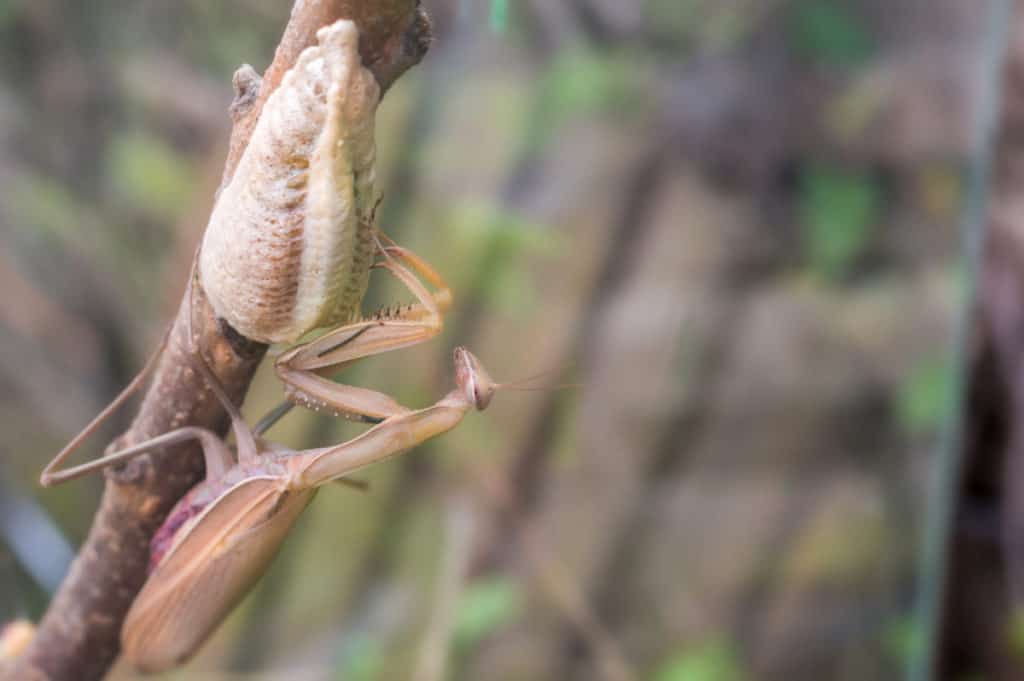Mantises can be found worldwide in different habitats, mostly in temperate and tropical regions. With such a diverse distribution across the world, it is intriguing how praying mantis species survive in the different climates and thrive, both in the wild and as pets.
As with all insects, the first stage of praying mantises; life is the egg.
But do they die after laying eggs?
As a general rule, no, praying mantis don’t die after laying their eggs. In fact, some species protect their eggs. However, praying mantis living in cooler regions with harsh winters die after laying eggs in autumn. Praying mantis in captivity can live for up to a year after laying eggs.
Let’s now delve into what happens in the wild that may influence the natural events in the mantises’ life. We shall look at what happens in the temperate zones and tropical regions.
Praying Mantis In The Wild
Praying Mantis In Temperate Zones
What happens to praying mantis in the wild, and their behavior is mostly determined by the weather and climate which in turn affects the availability of food and suitable habitats. As a result, breeding habits are guided and conform to the different environments in which praying mantis can be found.
It is important to note that most exotic pet praying mantis are originally from the tropics.
Food Sources
In the cooler temperate areas, the adults lay eggs in autumn and die, and that is the end of their natural life cycle. This can be attributed partly to the fact that the approach of winter deprives the praying mantis of their food sources.
Praying mantis are not very picky food-wise. The majority of mantids feed only upon live prey that they ambush.
Their diet consists of grasshoppers, cockroaches, butterflies, aphids, other insects as well as arthropods. Larger praying mantis feed on lizards, frogs, and occasionally small birds such as the hummingbird ( which can be found only in the tropics).
With the onset of winter, these foods become scarce.
If you are interested we have an entire article on the diets of praying mantis. The article is called, What Does A Praying Mantis Eat?
Temperature
Praying mantis thrive best at temperatures of between 20 to 25 degrees Centigrade, which is more or less room temperature. Outdoor winter temperatures can fall dramatically low and praying mantis cannot withstand and survive the freezing cold outside.
As adults, praying mantis don’t have the ability to undergo diapause or hibernate like some other insects that can slow down their metabolism to survive cold winters.
Reproduction
The eggs laid in autumn overwinter to hatch in the spring. The eggs undergo a delay in development (diapause) because of adverse weather conditions.
The mantis produces a froth-like mass from glands in the abdomen which hardens to create a protective capsule. This together with eggs inside is called an ootheca. It protects the eggs from predators and also buffers the eggs from the extremes of temperature.

The ootheca can be attached to a flat surface, wrapped around a plant, or simply be deposited on the ground depending on the praying mantis species.
People sometimes bring praying mantis ootheca indoors wanting to “protect” the egg mass from the cold winter weather. This is not a good idea! How so? Well, remember the ootheca you find outdoors is in diapause? The warmth indoors can cause nymphs to emerge early and be unable to find any food. In such a case, they will inevitably starve.
The number of eggs varies depending on the species and may range between 10 and 400. The eggs of the smaller species may hatch in 3 to 4 weeks while for the larger species 4 to 6 weeks is the normal duration. Depending on the species, the eggs may all hatch at once or in batches.
The hatched nymphs undergo three stages before they become adults; egg, nymph, and finally an adult. This process is called incomplete metamorphosis and does not have a pupal stage.
As a mantis nymph grows, it molts six to ten times before reaching the adult stage depending on the species.

Most praying mantises become sexually mature in two to three weeks and can mate. Some species of praying mantis can reproduce without males around to fertilize their eggs. The Brunner’s stick mantis found in the Southern United States is one example, the female reproduces parthenogenetically since no males have been recorded in this praying mantis species. Other species are :
- Sphomodromantis viridian
- Miomantis s.p
However, these two can also reproduce sexually.
The Brunner stick mantis is often confused with stick bugs. If you are interested in exploring the differences between these two insects check out this article we have written, Praying Mantis Vs Stick Bug. Are They The Same Thing?
Praying Mantis In Tropical Regions
In the tropics where there are no radical changes in the temperatures, praying mantis can mate at any time of the year. They have a wide choice of prey to eat because their habitats are teeming with many live food sources virtually throughout the seasons.
After mating and laying eggs, they continue to live naturally and go after prey. Some ground and bark species are known to actually guard their eggs. In the mantid family Tarachodidae, the mother guards the ootheca.

The inconspicuous Tarachodes Maurus in the family Eremiaphildae protects her eggs by positioning herself on bark with her abdomen on the ootheca. She moves very little until the eggs hatch and survives by ambushing passing prey. The eggs hatch after one to two months.
Praying mantis in tropical regions don’t have to contend with adverse or extremes of cold weather conditions as is the case in temperate zones.
While the climate may favor them, they do have many predators that shorten their lives. Praying mantis have a lifespan of 4 to 8 weeks for the smaller species and 4 to 6 months for the larger species.
Do Praying Mantis Live Longer In Captivity?
Praying mantis are much loved as pets and are easy to take care of. In captivity, the praying mantis needs to be provided with appropriate housing and feeding to ensure they live long and even reproduce. Praying mantis can live for about one year in captivity.
After reaching adulthood, which occurs after the final molting, Praying mantis can be mated two weeks after the event. Mating should be done in a spacious habitat.
Of great importance is to make sure you feed the female well before the male is introduced into the pet enclosure. This reduces the chance of the female eating the male in the mating process.
After mating the female lays eggs in an ootheca attached to a twig or the inside the habitat. This is why it is a good idea to prepare the habitat properly and leave at least a 5-inch space between the bottom of the housing and the twig. The hatched nymphs usually hang from the ootheca and drop to the bottom.
The female adult praying mantis does not die after laying eggs in captivity. They continue to feed and behave normally. However, let’s keep in mind that they can turn on the nymph mantises and eat them if they get hungry.
Some of the little praying mantis can also eat each other and it is a good idea to separate the bigger ones from the rest and move them to a different enclosure. After the second or third molt, they should not be kept in groups since many species have aggressive behavior towards each other.
As a general rule, keeping in mind that the many pet praying mantis are from the tropics, it is essential to keep them warm in their habitat. The ideal temperature is between 20 to 25 degrees Centigrade. Mantids also require an environment that has adequate humidity, which is important for them during and after molting to protect their sensitive body before the new exoskeleton hardens.
Spraying the cage with water every day is a good way of maintaining humidity. Alternatively, you can provide a small dish of water if your pet mantis is kept in a heated cage.
Will Praying Mantis Eggs Laid In Captivity Hatch?
Eggs laid in captivity will hatch in the normal way as long as conditions are conducive in their habitats.
There are some breeders of pet praying mantis species who specialize in this kind of business. They breed praying mantis in captivity for sale.
Can Praying Mantis Lay Eggs Without A Male To Mate With?
A few praying mantis species will lay eggs even without a male to fertilize their eggs. The Brunner’s stick mantis is a species that can reproduce parthenogenetically.
Others can reproduce both sexually or without mating with a male. Some examples of these are Sphomodromantis Viridian and Miomantis s.p.
Do Praying Mantis Lay Eggs During The Day Or At Night?
Praying mantises lay eggs during the daytime. Praying mantis are most active during the day when they do most of their hunting for prey. They also mate during the day when it’s quite hot.
The foamy egg mass that they produce dries and hardens best during the day, quickly forming the protective ootheca to ward off predators and the elements.
Will Praying Mantis Eat Their Eggs To Survive?
Praying mantises are not known to eat their eggs which are enclosed in a protective egg mass (ootheca). Certain species as aforementioned actually guard their own eggs until they hatch, with very little food for themselves.
They don’t move away from the eggs for up to two months. This happens with the tropical species only.
Praying mantis are, however, known to eat other members of the species. They are also known for practicing a pretty brutal form of sexual cannibalism where the female mantis eats their mates.
The larger mantises also eat the smaller ones. The nymphs are not to be left behind and they eat each other when they hatch and fall to the ground and start looking for food.
The Wrap Up
In temperate areas around the world, adult praying mantis do not survive the winter. The eggs that they lay in the autumn overwinter and hatch in the spring to begin the life cycle of mantids. The weather and food availability plays a big role in this cycle.
Adult praying mantis don’t have the ability to undergo diapause in order to survive the winter and so they perish, but only after laying eggs that overwinter and hatch in the spring. Eggs laid in captivity also hatch. On average Mantids live for about a year in captivity, but they live for up to approximately six months in the wild depending on species.
Praying mantis become sexually active about two weeks after the final molting. In the tropics, mating can occur at any time of the year.
Would like to know more about the reproductive process for other bugs? Check out some of these other articles we have written:
How Long Does It Take For Spider Eggs To Hatch?
Sources
https://www.minibeastwildlife.com.au/resources/australian-praying-mantises/
https://praying-mantis.org/how-many-babies-does-a-praying-mantis-have/amp/
https://animals.mom.com/stages-praying-mantis-life-cycle-6282.html
https://www.amentsoc.org/insects/caresheets/praying-mantids.html
https://www.thoughtco.com/praying-mantid-facts-1968525
https://en.m.wikipedia.org/wiki/Mantis
https://usmantis.com/pages/parthenogenesis-self-reproduction
